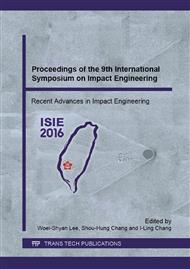[1]
LIANG Bin, CHEN Xiao-wei, JI Yong-qiang, et al. Experimental study on deep penetration of reduced-scale advanced earth penetrating weapon, J. Explosion and Shock Waves, 28 (2008) 1-9.
Google Scholar
[2]
HE Li-ling, CHEN Xiao-wei, XIA Yuan-min. A Review on the Mass Loss of Projectile J, Acta Armamentarii, 31(2010) 950-966.
Google Scholar
[3]
HE Xiang, XU Xiang-yun, SUN Gui-juan et al, Experimental investigation on projectiles' high—velocity penetration into concrete targets, J. Explosion and Shock Waves, 30(2010) 1-6.
Google Scholar
[4]
HAIJUN WU, YINAN WANG, FENGLEI HUANG. Penetration concrete targets experiments with non-ideal & high velocity between 800 and 1100m/s, J. International Journal of Modern Physics B, 22(2008) 1087-1093.
DOI: 10.1142/s0217979208046360
Google Scholar
[5]
Shan Yu, Huang Fenglei, Wu Haijun. The influence of projectile material on mass abrasion of high-velocity penetrator, C. Proceedings of the 28th International Symposium on Ballistics, Atlanta, USA, (2014).
Google Scholar
[6]
Alekseevskii V P. Penetration of a rod into a target at high velocity, J. Combustion Explosion & Shock Waves, 2(1966) 63-66.
DOI: 10.1007/bf00749237
Google Scholar
[7]
Tate A. Further results in the theory of long rod penetration, J. Journal of the Mechanics and Physics of Solids, 17(1969) 141-150.
DOI: 10.1016/0022-5096(69)90028-3
Google Scholar
[8]
Rosenberg Z, Marmor E, Mayseless M. On the hydrodynamic theory of long-rod penetration, J. International Journal of Impact Engineering, 10(1990) 483–486.
DOI: 10.1016/0734-743x(90)90081-6
Google Scholar
[9]
Zhang Lian-sheng et al. Model for long-rod penetration into Semi-infinite targets, J. Journal of Beijing Institute of Technology, 13(2004) 285-289.
Google Scholar
[10]
Wang P, Jones S E. An elementary theory of one-dimensional rod penetration using a new estimate for pressure, J. International Journal of Impact Engineering, 18(1996) 265–279.
DOI: 10.1016/0734-743x(96)89048-8
Google Scholar
[11]
Jones S E, Gillis P P, Foster J C. On the penetration of semi-infinite targets by long rods, J. Journal of Mechanics Physics of Solids, 35(1987) 121-131.
DOI: 10.1016/0022-5096(87)90031-7
Google Scholar
[12]
Li Zhi-kang. Analysis of Projectile Normal Penetration into Semi-Infinite Concrete Targets, D. Beijing, Beijing Institute of Technology, (2008).
Google Scholar
[13]
Wen H M, He Y, Lan B. A combined numerical and theoretical study on the penetration of a jacketed rod into semi-infinite targets, J. International Journal of Impact Engineering, 38(2011) 1001-1010.
DOI: 10.1016/j.ijimpeng.2011.07.001
Google Scholar
[14]
Chen X W, Li Q M, Transition from Non-deformable Projectile Penetration to Semihydrodynamic Penetration, J. Journal of Engineering Mechanics, 130(2004) 123-127.
DOI: 10.1061/(asce)0733-9399(2004)130:1(123)
Google Scholar
[15]
Wang Yinan. The mechanism of high-seed kinetic energy projectile penetration into concrete D. Beijing, Beijing Institute of Technology, (2009).
Google Scholar
[16]
WU Hai-jun. Experiment Research of Dynamic Rupture & Numerical Simulation of Reinforced Concrete Perforation, D. Beijing, Beijing Institute of Technology, (2003).
Google Scholar


